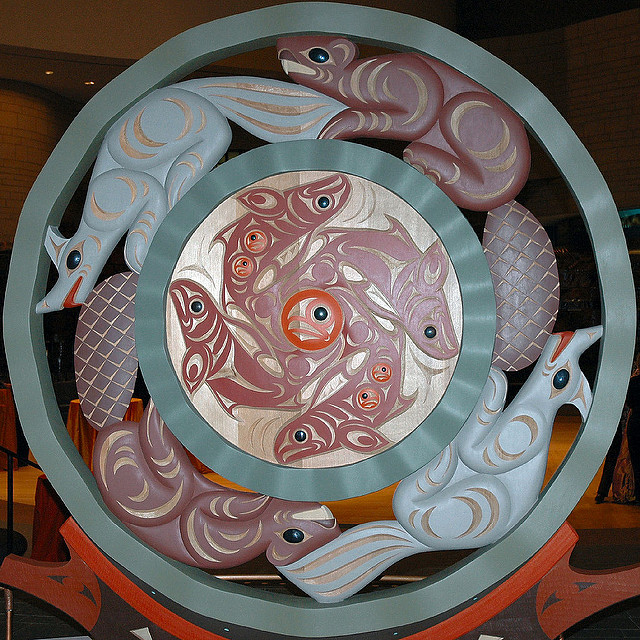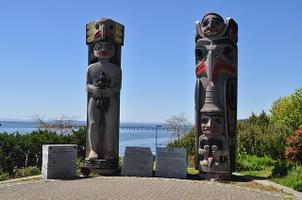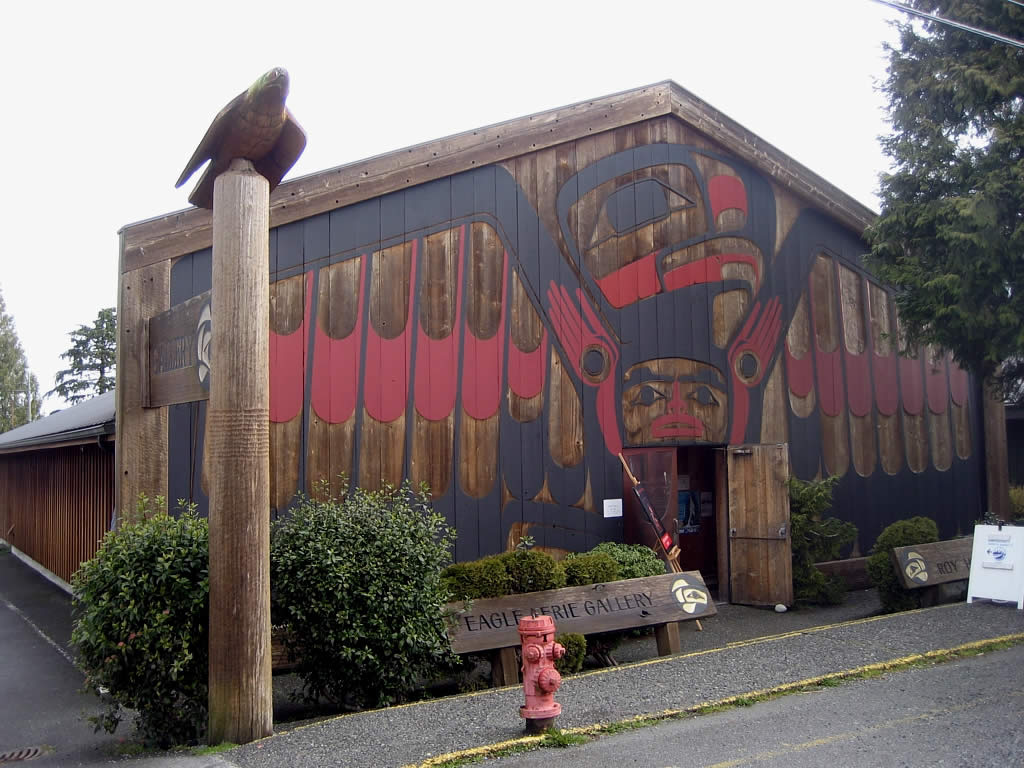
Early Career
Susan Point began her artistic career creating jewellery, using Northwest Coast artistic forms inspired by the Northern formline style. While on maternity leave from her job as a legal secretary, she took a jewellery-making course in 1981 that was offered to First Nations students by Vancouver Community College. According to Point, her use of Northern motifs never felt quite right, and her husband, Jeff Cannell, asked whether Coast Salish peoples had traditional imagery that she could draw upon. Around this time, Point and Cannell became familiar with a series of serigraphs by Coast Salish artist Stan Greene (serigraphy is a stencil process using a mesh stretched over a frame). These works were largely interpretations of the traditional Coast Salish spindle whorl, an instrument used to prepare wool for weaving. Inspired by Cannell’s question and Greene’s serigraphs, Point began to work exclusively in the Coast Salish style in both her jewellery and her prints.
Also in 1981, Point began producing drawings with pencil on paper. After reworking one of her ideas several times, she produced her first original graphic design, which was reproduced in April 1981 as her first serigraph. Entitled Salmon, it depicts four black-and-white salmon surrounding a small circle. The serigraph’s circular format was inspired by the Salish spindle whorls that Point had examined extensively in museum collections. She printed her first images at home on the kitchen table, and her children helped by carrying the prints to any available surface in the house to dry.
By July 1983, Point had produced Kwantlen, her first serigraph to incorporate the blending of colours. There was an immediate negative reaction to this print, with many observers claiming that it was not representative of traditional Northwest Coast art. “People reacted negatively,” Point said, “telling me it wasn’t Coast Salish art. It took a long time until it was accepted.”

Coast Salish Artistic Traditions
Despite the skill and creativity evident in Point’s early prints, art collectors and galleries did not immediately take to her work. This can be attributed in some part to the highly private and sacred nature of traditional Coast Salish art forms. Historically, Coast Salish peoples were unwilling to part with the objects they created, nor was it common for Salish producers to adapt their imagery to the production of curios for tourists. As a result, few Coast Salish artworks ended up in anthropological museums, meaning that both collectors and museum professionals have been more familiar with the art of the northern and central areas of the Northwest Coast.
Nonetheless, there was a period of time in the late 19th and early 20th centuries when the sale of Coast Salish cedar-root coiled baskets flourished, and Salish baskets in museum collections speak to the creative powers of the Coast Salish women who made them. Point’s mother, Edna Grant, was one of the last Musqueam women who knew how to make this kind of basket; Point therefore grew up observing her mother producing a traditional Coast Salish art form.

Key Influences
Point’s artworks often incorporate motifs related to traditional Coast Salish arts associated with women’s work. These motifs include symbols used in Salish weaving produced by women and designs carved on traditional women’s utensils, such as the spindle whorl.
Point has frequently used the spindle whorl in her artwork, from her limited edition prints to her monumental mixed-media sculptures. A small wooden disk with a central hole into which a spindle is inserted, the spindle whorl was traditionally used by Coast Salish women to spin sheep and mountain goat wool into yarn for the weaving of textiles. Coast Salish spindle whorls used by women are often decorated on the convex side with engravings that represent animal, floral, geometric and human imagery. Other designs include personal spirit powers or representations of guardian spirits (see also Indigenous People: Religion and Spirituality). All of these motifs have appeared in Point’s artworks.
Point lives at the mouth of the Fraser River, and in her prints she is often inspired by nature. Her imagery includes frogs, birds, grasses, flowers, sturgeons, killer whales, bears and deer. She has also represented her personal symbol, the ladybug, often in relation to the frog, which symbolizes the turning of the seasons. Many of Point’s works could be described as spiritual in nature, representing guides and other empowering figures, as in Free Spirit (1995), which depicts a thunderbird, the most powerful of all spirits in Northwest Coast mythology, with a woman’s face incorporated within its body.
Notable Commissions
Point continues to release several limited edition prints every year, and has remarked that she thinks prints are her most important works. However, she is perhaps best known for her many monumental public art commissions that draw on traditional Coast Salish imagery while employing a range of non-traditional materials such as cast iron, stainless steel, bronze, concrete, polymers and glass. In fact, Point was the first Northwest Coast artist to work with glass. Her first successful use of glass was the Land, Sea and Sky installation at the Vancouver International Airport (1993), a multimedia work that celebrates the interrelationship between these three elements at the western edge of the Fraser Valley delta, where the airport is now situated on the Musqueam territory’s most fertile lands.

Point’s work continues to be sought by public institutions, particularly in Seattle and British Columbia. She has completed three major commissions for the Vancouver International Airport — including Flight (Spindle Whorl), a 4.8 m engraved red cedar spindle whorl that serves as a centerpiece in the international terminal — as well as two house posts (inspired by 19th-century prototypes that once stood on the Musqueam Reserve) and a welcome figure for the University of British Columbia’s Museum of Anthropology, a sculpture for the Victoria Convention Centre, and a sculpture and wall installation mural for Langara College in Vancouver.
Among many other materials, Point now works with wood for many of her commissions. She was encouraged in this by Bud Mintz, the founder of Potlatch Arts in Vancouver, who was a friend and mentor from 1981 onwards. For further guidance, Point sought advice from John Livingston, a non-indigenous carver and instructor. In 1990, Livingston helped Point create a three-piece carved red cedar panel for a theatre/museum complex in the Sechelt Indian Government District in southern BC.
More recently, A Timeless Circle, a large-scale permanent bronze sculpture, was commissioned by the Municipality of Whistler for the 2010 Olympic Park Legacy in Whistler, BC.
Major Exhibitions and Publications
Point’s work has been included in a range of group exhibitions since the early 1980s, as well as several solo exhibitions. Her first exhibition, Art of the Northwest Coast, took place in 1982 at the London Regional Art Gallery in London, Ontario. New Visions: Serigraphs by Susan A. Point, Coast Salish Artist was organized by the University of British Columbia’s Museum of Anthropology and opened in 1986. Her work was included in a group exhibition at the Ethnological Museum of the University of Zurich, Switzerland, in 1989. She also had solo exhibitions at The Art Space Gallery in Philadelphia, Pennsylvania, in 1990 and at Motherland Gallery in Fukuoka, Japan, in 1999.
The Spirit Wrestler Gallery in Vancouver has held several exhibitions of Point’s work that have resulted in illustrated exhibition catalogues. These catalogues include essays that productively illuminate and contextualize Point’s work. Two such publications are Susan Point: Coast Salish Artist (2000) and Susan Point: Works on Paper (2014). The Vancouver Art Gallery also held the major exhibition Susan Point: Spindle Whorl from 18 February to 28 May 2017.
Honours and Legacy
Point is widely recognized as an important influence on the next generation of Northwest Coast artists, particularly women. When she began her career as a professional artist, the world of Northwest Coast art was largely male dominated. Point has received many honours and accolades, including four honorary Doctor of Fine Arts degrees. Her large carving The Beaver and the Mink (2004) was commissioned by the Canadian government as a gift to celebrate the new addition to the Smithsonian Institution’s National Museum of the American Indian in Washington, DC. She has also been appointed to the Royal Canadian Academy of Arts and the International Women’s Forum, and has received the YWCA Woman of Distinction Award. In 2010, she was named one of BC’s 100 most influential women by the Vancouver Sun, and in 2016, she received a Civic Merit Award from the City of Vancouver and Lifetime Achievement Awards from Emily Carr University and the BC Creative Achievement Awards.
Awards
- Honorary Doctor of Fine Arts, University of Victoria (2000)
- Honorary Doctor of Fine Arts, University of British Columbia (2000)
- National Aboriginal Achievement Award (2004)
- Lifetime member, Royal Canadian Academy of Arts (2004)
- Officer, Order of Canada (2005)
- Honorary Doctor of Fine Arts, Simon Fraser University (2008)
- Honorary Doctor of Fine Arts, Emily Carr University of Art and Design (2008)
- Queen Elizabeth II Diamond Jubilee Medal (2012)
- Civic Merit Award, Mayor’s Arts Awards, Vancouver (2016)
- Lifetime Achievement Award, Emily Carr University of Art and Design (2016)
- Lifetime Achievement Award, BC Creative Achievement Awards (2016)

 Share on Facebook
Share on Facebook Share on X
Share on X Share by Email
Share by Email Share on Google Classroom
Share on Google Classroom
